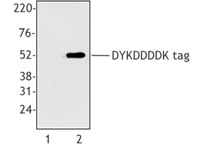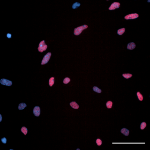- Clone
- W21023A (See other available formats)
- Regulatory Status
- RUO
- Other Names
- Oligodendrocyte transcription factor 2 (Olig2), Class B basic helix-loop-helix protein 1 (bHLHb1), Class E basic helix-loop-helix protein 19 (bHLHe19), Protein kinase C-binding protein 2 (PRKCBP2), RACK17, OLIGO2
- Isotype
- Rat IgG2b, κ
- Ave. Rating
- Submit a Review
- Product Citations
- publications

-

IHC staining of purified anti-Olig2 (clone W21023A) on formalin-fixed paraffin-embedded human cerebellum tissue. Following antigen retrieval using Tris-EDTA (10 mM Tris, 1 mM EDTA, 0.05% Tween-20, pH 9.0), the tissue was incubated without (panel A) and with (panel B) 5 μg/mL of primary antibody followed by incubation with Alexa Fluor® 647 goat anti-rat IgG (Cat. No. 405416) for 1 hour at room temperature. Nuclei were counterstained with DAPI (Cat. No. 422801). Images were captured with a 40X objective. Scale bar: 50 μm -

Rat cortical stem cells induced to differentiate via FGF withdrawal were fixed with 4% PFA Fixation Buffer (Cat. No. 420801) for 10 minutes and permeabilized with 100% ice-cold methanol for 10 minutes, and blocked with 5% FBS for 1 hour at room temperature. Cells were then stained with 5 μg/mL of purified anti-Olig2 (clone W21023A), followed by incubation with Alexa Fluor® 594 goat anti-rat IgG (Cat. No. 405422) for 1 hour at room temperature. Nuclei were counterstained with DAPI (Cat. No. 422801). Images were captured with a 60X objective. Scale bar: 50 μm
| Cat # | Size | Price | Quantity Check Availability | Save | ||
|---|---|---|---|---|---|---|
| 615951 | 25 µg | $160 | ||||
| 615952 | 100 µg | $400 | ||||
Olig2 is a transcription factor that plays a crucial role in the development and maintenance of the central nervous system. This transcription factor is a master regulator for oligodendrocyte cell specification. Olig2 activates the expression of myelin-associated genes in oligodendrocyte lineage cells, which are essential for proper neuronal function and transmission of nerve impulses. In addition to its role in oligodendrocyte differentiation and maturation, Olig2 also regulates the development and maintenance of motor neurons in the spinal cord and contributes to the proliferation and differentiation of neural stem cells. Dysregulation of Olig2 expression has been associated with several neurological disorders, including multiple sclerosis and gliomas, highlighting its importance in maintaining normal brain function. Being located on chromosome 21, dysregulation of Olig2 is also associated with Down Syndrome.
Product DetailsProduct Details
- Verified Reactivity
- Human, Rat
- Antibody Type
- Monoclonal
- Host Species
- Rat
- Immunogen
- Recombinant fragment of the N-terminus of mouse Olig2
- Formulation
- Phosphate-buffered solution, pH 7.2, containing 0.09% sodium azide
- Preparation
- The antibody was purified by affinity chromatography.
- Concentration
- 0.5 mg/mL
- Storage & Handling
- The antibody solution should be stored undiluted between 2°C and 8°C.
- Application
-
IHC-P - Quality tested
ICC - Verified - Recommended Usage
-
Each lot of this antibody is quality control tested by formalin-fixed paraffin-embedded immunohistochemical staining. For immunohistochemistry, a concentration range of 5.0 - 10.0 µg/mL is suggested. For immunocytochemistry, a concentration range of 1.25 - 5.0 μg/mL is recommended. It is recommended that the reagent be titrated for optimal performance for each application.
- Application Notes
-
This product is not recommended for use in Western Blot. Although a band of the correct size was observed when testing in human, mouse and rat brain, there are multiple non-specific bands.
- Additional Product Notes
-
This product does not recognize mouse Olig2 by IHC-F.
For IHC-P, we recommend antigen retrieval using Tris-EDTA (10mM Tris, 1mM EDTA, 0.05% Tween-20, pH 9.0).
For ICC, we recommend either 4% PFA Fixation Buffer (Cat. No. 420801) for 10 minutes and permeabilization with 0.5% Triton X-100 for 10 minutes, or 4% PFA Fixation Buffer (Cat. No. 420801) for 10 minutes and permeabilization with 100% ice-cold methanol for 10 minutes. - RRID
-
AB_2941623 (BioLegend Cat. No. 615951)
AB_2941623 (BioLegend Cat. No. 615952)
Antigen Details
- Structure
- Olig2 is a 323 amino acid protein with a predicted molecular weight of 32.38 kD.
- Distribution
-
Nucleus
- Function
- Transcription factor
- Cell Type
- Neural Stem Cells, Oligodendrocytes
- Biology Area
- Cell Biology, Neuroscience, Neuroscience Cell Markers, Transcription Factors
- Antigen References
-
- Zhang K, et al. 2022. Nat Commun. 13:1423.
- Xu R, et al. 2019. Cell Stem Cell. 24:908-926.
- Sock E, Wegner M. 2021. Dev Neurobiol. 81:892-901.
- Szu J, et al. 2021. Front Neurosci. 15:659601.
- Gene ID
- 10215 View all products for this Gene ID
- UniProt
- View information about Olig2 on UniProt.org
Related Pages & Pathways
Pages
Related FAQs
Other Formats
View All Olig2 Reagents Request Custom Conjugation| Description | Clone | Applications |
|---|---|---|
| Purified anti-Olig2 | W21023A | IHC-P,ICC |
Customers Also Purchased


Compare Data Across All Formats
This data display is provided for general comparisons between formats.
Your actual data may vary due to variations in samples, target cells, instruments and their settings, staining conditions, and other factors.
If you need assistance with selecting the best format contact our expert technical support team.
 Login/Register
Login/Register 











Follow Us